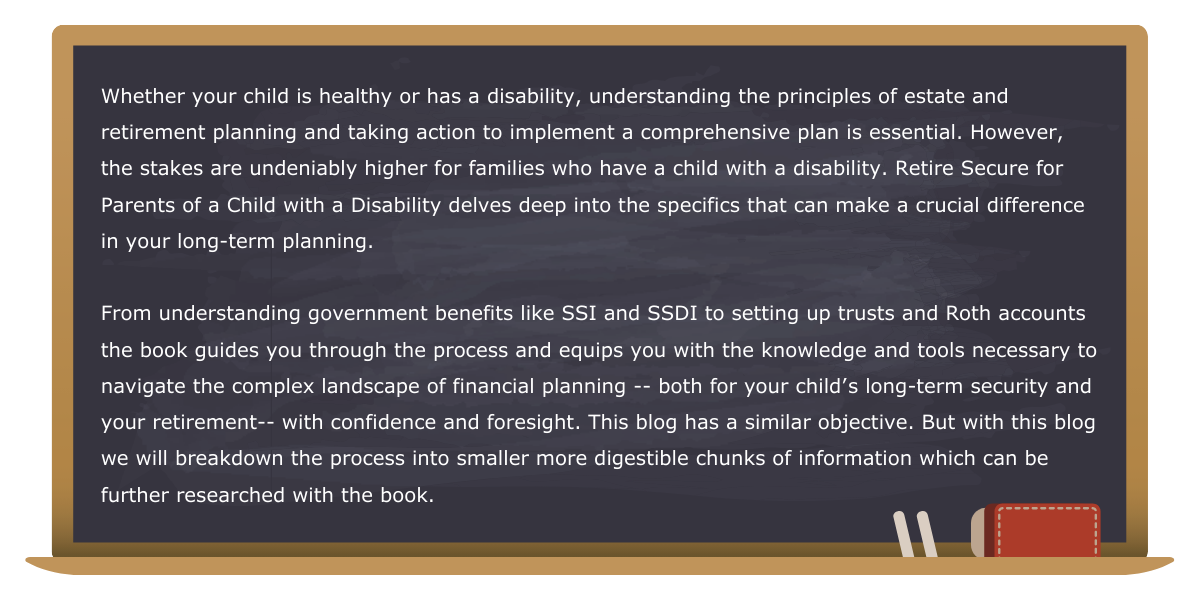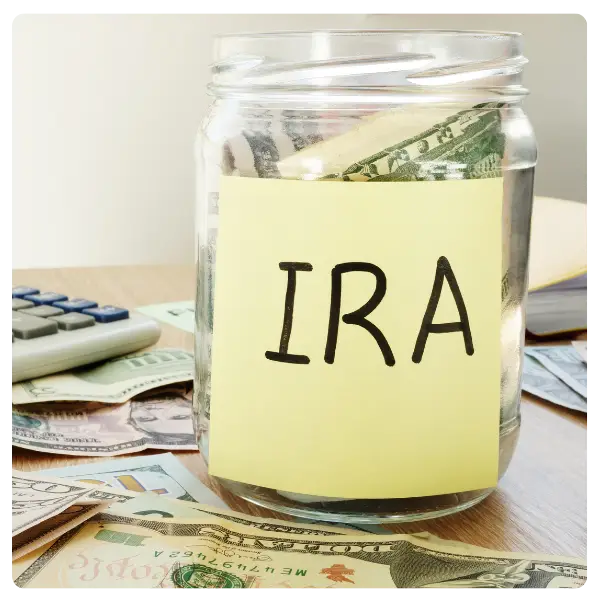Blog for Parents of a Child with a Disability

Rules that Govern Taking Money Out of IRAs
General Introduction
In the previous post we covered the basics of contribution limits to various types of IRAs. Well, just as the IRS imposes restrictions and limits on contributions it also impose rules and regulations on when and how you can withdraw money from those same retirement accounts.
Distribution Rules for Traditional IRAs
1. Traditional IRA withdrawals are generally taxable at the federal level, but not necessarily at the state level.
Special note: If you make nondeductible contributions to your IRA, you will have basis (in other words, money that you put into the account, that you already paid tax on, and on which the IRS can’t tax you again). If all of your IRA contributions were tax deductible, you have no basis in the account. It is important to know if you have non-deductible contributions (otherwise known as “basis”) in your nondeductible IRA, because you don’t want to pay more taxes on your IRA withdrawal than required.

The burden of proving that a portion of the withdrawal is not taxable falls on you, so I hope you filed a Form 8606 to keep track of the basis in your IRA. This form should be filed every year as an attachment to your tax return once you have any basis in your IRA. When a withdrawal is made from an IRA with basis, a calculation is made to determine what percentage of the money in the account is your contribution, and what percentage reflects earnings on your contributions.
Let’s say your non-deductible contributions were $20,000 and the value of your IRA at year-end after taking a $10,000 withdrawal is $90,000. In this case, 20 percent of the withdrawal is considered a return of your own money and is not taxable. The remaining $8,000 is taxable. (My book, The Roth Revolution, covers in detail a great technique for converting after-tax or nondeductible IRAs or after-tax dollars inside a Traditional 401(k) to Roth IRAs without paying any tax. Please visit https://PayTaxesLater. com, for more information about that book.) An example of this strategy is also presented in Chapter 7 of RSPCD.
2. All Traditional IRA withdrawals prior to age 59½ are subject to an additional 10 percent penalty (for amounts exceeding basis) unless the withdrawal falls under one of the following exemptions:
- They are made to a beneficiary (or the individual’s estate) on or after the individual’s death.
- They are attributable to the individual with a total or permanent disability.
- They were used for qualified first-time home purchase expenses.
- The distributions are not more than your qualified higher education expenses.
- They were used for qualified medical expenses that exceed 7.5 percent of AGI.
- The distributions are not more than the cost of your medical insurance due to a period of unemployment.
- They are part of substantially equal periodic payments over the life of the participant—that is, distributions qualifying under Section 72(t) (which we do not cover in this book) for exemption from the premature distribution penalty.
- They are due to an IRS levy on the account.
- The distribution is a qualified reservist distribution.
- The distribution is a coronavirus-related distribution from January 1, 2020, to December 30, 2020, up to an aggregate limit of $100,000. The CARES Act allows you to spread out your taxes for the withdrawal over three years (2020-2022). If you repay some or all of the distribution back into your IRA, the IRS considers that amount a ‘rollover’ and not subject to income tax.
With the passing of SECURE Act 2.0, new exceptions were added for penalty-free distributions:
- Qualified Disaster Recovery Distributions are retroactively permanently reinstated to disasters occurring on or after January 26, 2021. If a distribution is made within 180 days of the disaster occurring, up to $22,000 for expenses related to a federally declared disaster can be spread equally over three years beginning with the year of distribution unless the person elects to report the full amount in the year of distribution. The taxpayer may also repay the distributions back within 3 years of the time the distribution is received.
- Effective in 2023, a distribution taken by someone with a terminal illness that will cause death within seven years as certified by a physician qualifies.
- Effective in 2024, a distribution taken by a victim of domestic abuse (physical, psychological, sexual, emotional, or economic abuse) during the preceding one-year period can be eligible for penalty relief up to the lesser of $10,000 (indexed for inflation) or 50% of the account value.
- Effective in 2024, up to $1,000 per calendar year can be distributed for personal or family emergency expenses to meet unforeseeable or immediate financial needs. No further emergency distributions are permitted during the three-year repayment period unless the funds are repaid, or new contributions are at least equal to the distribution.
- Effective in 2026, withdrawals for Qualified Long-Term Care Distributions of up to the lesser of 10% of an individual’s vested balance or $2,500 (adjusted for inflation) can be taken annually to pay for long-term care insurance.
3. All Traditional IRAs are subject to RMDs after age 72, 73 or 75, depending on the year of your birth. If you were born in 1950, your RMDs began at age 72. If you were born between 1951 and 1959, your RMDs start at age 73. For those born in 1960 or later, RMDs don’t start until age 75.
Distribution Rules for Roth IRAs
1. In order to take completely tax-free (or qualified) withdrawals from a Roth IRA that has grown in value, five years must have elapsed since opening the There is a separate five-year holding period for each Roth IRA conversion as well (for more details see Chapter 16 of RSPCD).
Distributions must be made on or after age 59½, unless one of the following special circumstances applies:
- A distribution is made to your beneficiary (or your estate) on or after your death.
- A distribution is attributable to your disability.
- A distribution is made for a qualified first-time home purchase expense up to $10,000 (lifetime maximum).
2. This five-year restriction also applies to the beneficiary of a Roth IRA whose owner dies before the five-year period has The beneficiary may withdraw funds tax-free as long as they do not exceed the contribution amount, but they must wait until the five-year period has passed before being able to enjoy tax-free withdrawal of the Roth IRAs earnings.
3. Withdrawals prior to age 59½ may be taken without tax or penalties to the extent of previous annual contributions.
4. Withdrawals in excess of previous contributions made before the five-year holding period is met are taxable, but penalty-free under the following circumstances:
- For qualified college expenses for yourself, spouse, child or grandchild.
- For qualified unreimbursed medical expenses that exceed 5 percent of AGI.
- For health insurance premiums or unreimbursed medical expenses paid for certain unemployed individuals.
- If withdrawals are part of substantially equal periodic payments over the life of the participant.
- If the distribution is part of an IRS levy.
- You are the beneficiary of a deceased IRA owner.
- If you withdraw up to $5,000 in the year after the birth or adoption of your child.
- The withdrawal was made when you were a reservist.
5. All other withdrawals (that don’t meet the exceptions) prior to age 59½ that are in excess of previous contributions are taxable and subject to a 10 percent penalty.
6. Roth IRA amounts are not subject to RMDs during the original owner’s lifetime.
Furthermore, a Roth IRA owner can designate their spouse as the beneficiary who, upon the Roth IRA owner’s death, would have the option of postponing RMDs until the second death. After the surviving spouse’s death, the subsequent beneficiary (usually a child) would be required to take nontaxable minimum distributions of the Inherited Roth IRA over 10-years in accordance with the new rules in the SECURE Act. Distributions do not need to be taken every year, but all of the Roth IRA money must be distributed by year 10. (For more details see Chapter 10 of RSPCD for distribution rules for Inherited IRAs and Inherited Roth IRAs.)
If, however, the beneficiary has a disability or chronic illness and qualifies as an eligible designated beneficiary (EDB) (please see Chapter 11 and 12 for more details), then the child can stretch the Inherited Roth IRA over their lifetime like the pre-2020 rules.
Because of this exception to the new distribution requirements for Inherited retirement plans, Roth IRAs are an ideal asset to leave to your child with a disability or chronic illness if they qualify as an eligible designated beneficiary (EDB).
Defining of the Five-Year Holding Period
The five-year holding requirement for Roth IRAs is intended to promote long-term savings. The five-year clock starts ticking on January 1 of the tax year associated with the first contribution or conversion, which actually results in making the five-year waiting period less than five years. The period begins on the first day of the tax year for which a contribution is made. If you open a Roth IRA account for the 2023 tax year by making a contribution on April 15, 2024 (the last day you can make your Roth IRA contributions for 2023), the five-year period is from January 1, 2023, to December 31, 2027.
To achieve the same five-year period, start date when opening a Roth IRA account using a Roth IRA conversion, you must make the conversion by December 31, 2023 (the last day you can make your Roth IRA conversions for 2023). Pursuant to these Roth IRA rules, if you suddenly need the money the day after or at any time after you make the contribution, you can take out the amount you contributed, free of tax. Any interest or gains, however, have to remain in the account for five years, in order to become tax free. Note, however, that the IRS has a process called “ordering rules” that determine if there is tax due on your distribution.
Distributions are ordered as follows: (For a complete example of how this might be applied see Chapter 3 in RSPCD)
- your contributions,
- conversion and rollover contributions, on a first-in, first out basis (generally, taken from the earliest year first), and
- earnings on contributions.
How to Think About the Five-Year Holding Period
Wealthy clients and readers raise a lot of questions about the five-year holding period. What I really want to do when I hear that question is yell, “Why do you care?” It is extremely unlikely that anyone would need to spend all of their money at one time. Let’s face it, if you did, you’d be broke, and the five-year holding period on the Roth account would be the least of your worries. Realistically, most people will spend their retirement savings over a period of many years. And the people who have a Roth IRA as part of their retirement accumulations generally have at least some after-tax money and some Traditional IRA or retirement plan funds—at least, this would be my advice. But because the Roth IRA is the last money I want people to spend, it should not matter that there is a five-year waiting period to achieve tax-free growth. The Roth’s advantages almost always more than make up for any lack of liquidity resulting from the five-year rule.
Conclusion
The previous post dealt with contribution limits. This one with details about how the money eventually is withdrawn. The next post will look at the big picture and weigh in on the advantages and disadvantages of Roth IRAs. What makes Roth so great when compared to a Traditional IRA, and things to consider when weighing which plans to contribute to.

